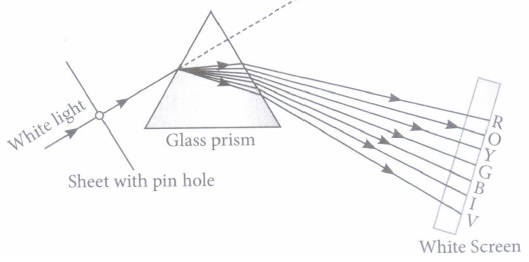CBSE Board Exam is on the way, so you must practice some good Case Study Questions Class 10 Science to boost your preparation to score 95+% on Boards. In this post, you will get Case Study and Passage Based Questions that will come in CBSE Class 10 Science Board Exams.
Join our Telegram Channel, there you will get various e-books for CBSE 2024 Boards exams for Class 9th, 10th, 11th, and 12th.
In CBSE Class 10 Science Paper, Students will have to answer some questions based on Assertion and Reason. There will be a few questions based on case studies and passage-based as well. In that, a paragraph will be given, and then the MCQ questions based on it will be asked.
The Human Eye and The Colourful World Case Study Questions With Answers
Here, we have provided case-based/passage-based questions for Class 10 Science Chapter 11 The Human Eye and The Colourful World
Case Study/Passage-Based Questions
Question 1:
When white light is incident on one refracting surface of the prism, the light splits up into constituent colours violet, indigo, blue, green, yellow, orange and red. The process of splitting of white light into its seven constituent colours is called dispersion. When the dispersed white light is made to fall on a screen, we get the band of seven colours is called the spectrum of white light. Red colour bends the least on passing through the prism and violet colour bends through maximum angle on passing through the prism.
(i) The splitting of white light can be done by
| (a) lens | (b) prism |
| (c) mirror | (d) none of these |
Answer: (b) prism
(ii) Which property of light is used by prism to form a spectrum?
| (a) Reflection | (b) Refraction |
| (c) Dispersion | (d) Scattering |
Answer: (b) Refraction
(iv) When a red light passes through a prism, it
(a) will not split
(b) will split into seven colours
(c) will split into white colour
(d) will split into many different colours
Answer: (a) will not split
(v) The spectrum produced by the white light by a prism is called
| (a) pure spectrum | (b) impure spectrum |
| (c) monochromatic spectrum | (d) none of these. |
Answer: (b) impure spectrum
Question 2:
Atmospheric refraction is the phenomenon of bending of light on passing through the earth’s atmosphere. As we move above the surface of the earth, the density of air goes on decreasing. Local conditions like temperature etc. also affect the optical density of the earth’s atmosphere. On account of atmospheric refraction, stars seen appear higher than they actually are; advanced sunrise; delayed sunset, the oval appearance of the sun at sunrise and sunset; stars twinkle, planets do not.
(i) Due to atmospheric refraction, the apparent length of the day
(a) increases
(b) decreases
(c) remains the same
(d) all of these
Answer: (a) Due to atmospheric refraction, apparent length of the day increases by 4 minutes.
(ii) Apparent position of the star appears raised due to
(a) atmospheric refraction
(b) scattering of light
(c) both (a) and (b)
(d) none of these
Answer: (a) Apparent position of the stars appears raised due to atmospheric refraction.
(iii) The sun appears oval-shaped or flattened due to
(a) dispersion
(b) scattering
(c) atmospheric refraction
(d) cannot say
Answer: (c) atmospheric refraction
(iv) Twinkling of stars and non-twinkling of planets is accounted for by
(a) scattering of light
(b) dispersion of light
(c) atmospheric refraction
(d) none of these
Answer: (c) atmospheric refraction
(v) In absence of atmosphere, the colour of sky appears
(a) blue
(b) black
(c) red
(d) yellow
Answer: (d) yellow
Case Study 3: The human eye is a complex organ that enables us to perceive the world around us. It consists of various parts that work together to provide vision. The cornea is the transparent outer covering of the eye that helps in focusing light. The iris, the colored part of the eye, controls the amount of light entering the eye by adjusting the size of the pupil. The lens, located behind the iris, further focuses the light onto the retina, which contains light-sensitive cells called rods and cones. These cells convert light into electrical signals, which are then transmitted to the brain via the optic nerve. The brain processes these signals and interprets them as visual images. The eye is capable of adjusting its focal length through a process called accommodation, allowing us to see objects at different distances clearly. The eye is also sensitive to different colors due to the presence of cones that respond to specific wavelengths of light. Understanding the functioning of the human eye and the properties of light helps us comprehend vision, perception, and phenomena such as refraction, dispersion, and the formation of images.
What is the function of the cornea?
a) Controlling the amount of light entering the eye
b) Focusing light onto the retina
c) Transmitting electrical signals to the brain
d) Providing vision
Answer: b) Focusing light onto the retina
What part of the eye controls the amount of light entering the eye?
a) Cornea
b) Iris
c) Lens
d) Retina
Answer: b) Iris
Where are the light-sensitive cells called rods and cones located?
a) Cornea
b) Iris
c) Lens
d) Retina
Answer: d) Retina
How are visual images transmitted to the brain?
a) Via the cornea
b) Via the iris
c) Via the optic nerve
d) Via the lens
Answer: c) Via the optic nerve
What is the process called that allows the eye to adjust its focal length?
a) Accommodation
b) Refraction
c) Dispersion
d) Reflection
Answer: a) Accommodation
Hope the information shed above regarding Case Study and Passage Based Questions for Class 10 Science Chapter 11 The Human Eye and The Colourful World with Answers Pdf free download have been useful to an extent. If you have any other queries about CBSE Class 10 Science The Human Eye and The Colourful World Case Study and Passage Based Questions with Answers, feel free to comment below so that we can revert back to us at the earliest possible.
By Team Study Rate


